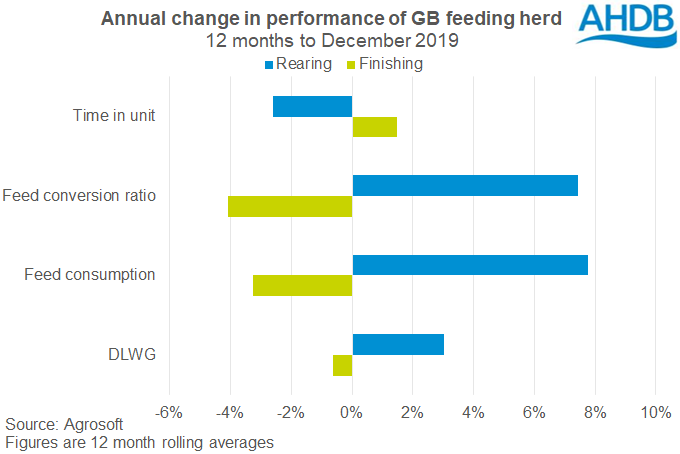Mixed performance for GB feeding herd
Thursday, 2 April 2020
By Felicity Rusk
The latest performance data from Agrosoft shows a mixed performance in the feeding herd over the 12 months to December 2019.
The rearing herd has recorded a considerable uplift in growth rate, although this is likely a result of higher feed inputs rather than gains in efficiency. In contrast, finishing pigs utilised feed more efficiently. However, a reduction in feed consumption did not translate into more rapid weight gain.

Rearing herd
Pigs at the rearing stage gained marginally more weight per day in the 12 months ending December 2019 compared to the previous year. The daily live weight gain (DLWG) for this period averaged 484g, 14g/day more when compared to the previous year. As a result, pigs spent on average two fewer days at the rearing unit and were on average 300g heavier at the point of transfer.
The improvement in growth rates is likely also a reflection of higher feed usage. Across the rearing stage, feed consumption averaged 53.9kg/head in the 12 months to December 2019. This equates to an additional 3.9kg (8%) more than in the same period in the previous year. A combination of lower feed costs (-3%) and strong finished pig prices may have given producers the incentive to increase feed usage to “push” animals on.
However, while feed usage was up on the year, rearing pigs were converting this feed less efficiency. In the 12 months to December 2019, the feed conversion ratio (FCR) averaged 1.83, 0.13 more than the previous year. This means that an additional 130g of feed was required for every 1kg of weight gained. This loss in efficiency has equated to an additional 1.3p on variable costs.
Finished herd
In contrast, feed usage at the finishing stage recorded a decline. In the 12 months ending December 2019, feed consumption during the finishing staged totalled 197.7kg/head, 6.7kg (-3%) less than during the same period in the previous year.
However, pigs at the finishing stage were more efficient in the 12 months ending December 2019, compared to the previous year. The FCR averaged 2.68, 0.11 lower than the same across the same period in the previous year. This means 110g less feed was required for each 1kg of weight put on by a pig.
This improvement in feed efficiency equated to a 2.4p saving in the variable costs.
However, while pigs at the finishing stage were more efficient, this did not translate into higher weight gain. The DLWG averaged 860g in the 12 months ending December 2019, 6g/day less than in the year before. The slightly slower growth along with finishing pigs to a heavier weight meant pigs were in the finishing unit for an additional day on average compared to the previous year. Together, these added around 0.7p to the variable costs compared to last year.
Sign up for regular updates
Subscribe to receive pork market news straight to your inbox. Simply complete our online form.
While AHDB seeks to ensure that the information contained on this webpage is accurate at the time of publication, no warranty is given in respect of the information and data provided. You are responsible for how you use the information. To the maximum extent permitted by law, AHDB accepts no liability for loss, damage or injury howsoever caused or suffered (including that caused by negligence) directly or indirectly in relation to the information or data provided in this publication.
All intellectual property rights in the information and data on this webpage belong to or are licensed by AHDB. You are authorised to use such information for your internal business purposes only and you must not provide this information to any other third parties, including further publication of the information, or for commercial gain in any way whatsoever without the prior written permission of AHDB for each third party disclosure, publication or commercial arrangement. For more information, please see our Terms of Use and Privacy Notice or contact the Director of Corporate Affairs at info@ahdb.org.uk © Agriculture and Horticulture Development Board. All rights reserved.

